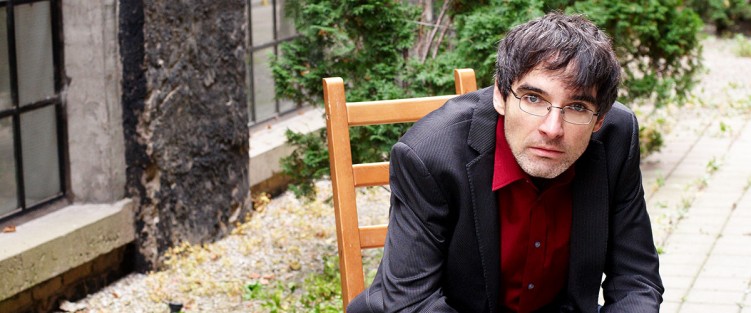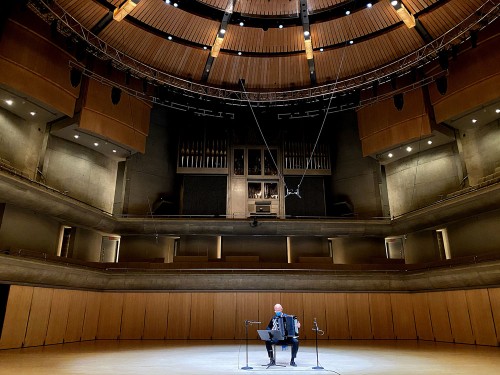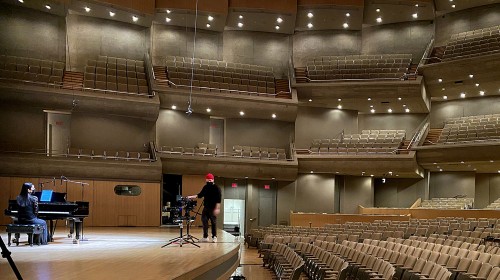 One Sunday morning a few years ago, when the possibility of a multi-year pandemic seemed lightyears remote, I assisted in tidying up at a small event at a local community centre. Absentmindedly humming as I stacked chairs, I was unaware of my barely audible personal music-making.
One Sunday morning a few years ago, when the possibility of a multi-year pandemic seemed lightyears remote, I assisted in tidying up at a small event at a local community centre. Absentmindedly humming as I stacked chairs, I was unaware of my barely audible personal music-making.
Until a friend brought my attention to it asking, “What song is that?” “There’s always a song in my heart,” I blurted out enigmatically, but with a smile. Though an honest reply, it immediately felt glib. But it stuck with me, an off-the-cuff remark with implications which occasionally still bear reflection as we fast forward to the second calendar year of the current pandemic and once again try to take stock of how musicians and the venues they work in are coping with our shifting and often confusing regulatory environment.
While most Toronto music venues have been closed for “business as usual” since last March, many had also found ways to come back to at least a semblance of life with examples of innovative livestream concerts or video productions (as I have reported in several recent stories, notably Exquisite Departures in Trying Times in November and most recently Modal Stories Are Alive and Well in the Labyrinth).
Then on January 14, 2021 the Premier of Ontario announced the latest emergency stay-at-home order. At the stroke of 12 that day almost all the province’s struggling music venues were forced to close their doors again, even virtually. It prompted a new wave of concert cancellations and postponements, an echo of the cancellation tsunami that tore up the live events calendar during COVID-19’s first wave. It sent musicians who could work back home, isolated once again.
“We can’t film, record or livestream anything. Our theatres are closed,” said a dispirited-sounding Mervon Mehta, the executive director of performing arts for the Royal Conservatory of Music. “We’re losing the ability to engage our audience and put some music in front of them, even on a screen.”
At least one small venue, however, has been able to pivot hard and fast. West-end downtown Toronto’s Array Studio, for example, has come up with a “contactless production strategy” for its in-studio recording projects. As of this writing, at any rate, it means that all technical setups can be done by the house technician in advance, including mic placement and lighting, with sessions conducted remotely from the studio booth using a talkback system to communicate, with a screen, allowing clients views from all the cameras in the space. But they are definitely the exception to the rule, at least in part because of the size of the venue. To come back to my first remark, right now, where venues are concerned, the larger the size of the heart, the less music there can be in it.
 Music for Self-Isolation: Just one day before the January 14 provincial stay-at-home order came into force, Toronto composer and pianist Frank Horvat wrapped a three-day recording session of his Music for Self-Isolation at one of the city’s premier venues, Roy Thomson Hall. The timing couldn’t have been better for an extraordinary exercise that had caught my attention on a variety of levels, and that I had been following on my Facebook feed for days.
Music for Self-Isolation: Just one day before the January 14 provincial stay-at-home order came into force, Toronto composer and pianist Frank Horvat wrapped a three-day recording session of his Music for Self-Isolation at one of the city’s premier venues, Roy Thomson Hall. The timing couldn’t have been better for an extraordinary exercise that had caught my attention on a variety of levels, and that I had been following on my Facebook feed for days.
I called Horvat the day after the January 14 announcement about the nick-of-time RTH session to talk about the project’s genesis and trajectory. He explained that early in the COVID-19 global pandemic, he had felt deep empathy with musician friends as they coped with the uncertainty of cancelled concerts and the strain of isolation. Feeling isolated at home too, he began to think about composing a work each day, calling the multi-faceted project, Music for Self-Isolation.
“It dawned on me that I could at least provide musical friends with new compositions while they were in self-isolation,” he said. “So in the spring of 2020 I composed 31 new short pieces, each of music for an unaccompanied solo instrument or voice, or for a duo of musicians self-isolating together. With the cancellation of performances, COVID-19 has adversely impacted the world’s music community. This project is my attempt to raise the spirits of fellow musicians and the community at large as we continue to traverse through uncertain times. We might be self-isolating but we are never alone… we have music.”
Horvat composed his first piece in late March 2020 , with a new one every weekday until the first days of May. “Each score is around two minutes, a miniature creative act I could complete in a day and share with musicians on social media right away. I also thought they would amount to a satisfying suite when performed together,” he added. His website hosts the sheet music for the 31 works, downloadable for free.
While Horvat freely admits he launched the Music for Self-Isolation project to keep himself busy, he was surprised at the positive reception that began to build among national and even international musicians. “The very first piece in the series, a flute solo, has resonated with the flute community, as have the cello and violin solos too. I feel very humbled by that.”
An indication of the work’s welcome reception is that some 150 publicly shared video performances of individual pieces have already been posted online to date, a growing number of which have been uploaded to Horvat’s website, frankhorvat.com.
“I’ve invited everyone to play them, not just professional musicians,” he clarifies. “It’s been particularly rewarding to privately hear from amateurs how proud they were of their performance, how it gave them a sense of purpose, of doing something relevant while in self-isolation.” One of the unexpected things has been seeing some musicians who play instrument A deciding to interpret piece B scored for another instrument. “I found that some of the compositions work quite well on several instruments. In fact the entire Music for Self-Isolation project has turned out to be very much community-minded and interactive.”
Sharing performances online prompted further conversations about the challenges musicians were facing during the pandemic. This inspired Horvat to start Phase 2 of Music for Self-Isolation – Pandemic Stories. He interviewed eight musicians who had posted videos and with the support of the Canada Council for the Arts, produced audio documentary compositions, also accessible on his website. “I felt more of us needed to hear about their hopes, dreams and fears for themselves and the arts and culture sector in order to heal and move forward together.”
Then with the pandemic still raging and musicians still not being able to get back to work, Horvat decided last fall to produce an album of the compositions to capture this moment in history. From January 11 to 13, 2021, 25 musicians converged on Toronto’s iconic (and empty) Roy Thomson Hall, one at a time, to record all 31 solo and duo pieces. Horvat chose the hall for its pristine acoustics, he says, “while at the same time capturing the poignancy of musicians performing in a cavernous empty hall. In addition, we also individually recorded parts of a new large ensemble work, Together in Spirit. Although we couldn’t be together to record it, technology allows us to imagine the time when we will be able to return to playing together.”
 With the support of the Toronto Arts Council and FACTOR, the album of these recordings is set to be released on the Centrediscs label in the spring of 2021, commemorating the first anniversary of the start of the pandemic lockdown in Canada. A documentary was also filmed capturing the recording process. Adding interviews chronicling the musicians’ stories of the pandemic, it will be screened later this year by Tiny Pictures.
With the support of the Toronto Arts Council and FACTOR, the album of these recordings is set to be released on the Centrediscs label in the spring of 2021, commemorating the first anniversary of the start of the pandemic lockdown in Canada. A documentary was also filmed capturing the recording process. Adding interviews chronicling the musicians’ stories of the pandemic, it will be screened later this year by Tiny Pictures.
Toronto clarinetist extraordinaire Peter Stoll, one of the musicians who participated in the recording, enthusiastically captured the spirit of the moment writing on his Facebook page: “Surprisingly warm and intimate-sounding acoustics for a single clarinet in that huge space! … So weird to be heading out of the house to play a gig for the first time in almost a year. Crazy, crazy times!”
Eager to spread the benefits of his Music for Self-Isolation project broader, Horvat states that he “is proud to support the efforts of the Unison Benevolent Fund (unisonfund.ca), a non-profit, registered charity that provides counselling and emergency relief services to the Canadian music community.”
If music is an essential aspect of our humanness, responses to the pandemic like Horvath’s make it clear that musicians are essential workers. They provide a valuable, though admittedly hard-to-define, essential quality to our physical, mental, emotional and spiritual health, particularly during times of adversity.
Musicians who have performed physically distanced in parks, parking lots, on the streets, balconies, porches and patios during warmer weather have been met with impromptu crowds savouring every live sonic moment. Whatever the format, they have served to remind us that the living performance of music in its infinite forms, actively listened to, is among our species’ most mysterious and highest order skills. It cuts across all cultures and all social strata.
To those who have persevered through the numerous punishing challenges we’ve experienced over the pandemic year 2020: kudos. History tells us we will make it through 2021 too – with a song in our hearts.
Andrew Timar is a Toronto musician and music writer. He can be contacted at worldmusic@thewholenote.com.



